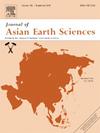Potential geomagnetic instability during the Last Deglaciation: High-resolution paleomagnetic evidence from the South China Sea
IF 2.7
3区 地球科学
Q2 GEOSCIENCES, MULTIDISCIPLINARY
引用次数: 0
Abstract
The Last Deglaciation has been marked by numerous reports of geomagnetic excursions, though controversies persist due to uncertainties in their timing and the inconclusiveness of supporting evidence. In this study, we present new paleomagnetic data from ultra-high sedimentation rate core (up to 834 cm/kyr) from the South China Sea, which may reflect geomagnetic instability during this period. Based on 12 AMS 14C dates, we identify multiple intervals of reversed inclination between 14.5 and 11.5 ka. Our detailed rock magnetic and sedimentological analyses, in conjunction with the presence of shallow inclination anomalies in nearby records, suggest that these deviations likely represent genuine geomagnetic signals linked to excursion events. The observed transient and discontinuous directional changes, along with the geographically concentrated nature of our dataset, lead us to hypothesize that the sedimentary low-pass filter effect and the regionally confined occurrence of excursions contribute to the enigmatic nature of these anomalies in previous studies. The rapid and frequent directional shifts observed highlight the severe instability of the geomagnetic field during this period, potentially driven by non-dipole components. Nevertheless, further investigations are essential to confirm the validity of these hypotheses and to deepen our understanding of geomagnetic instability during this period.

末次冰期潜在的地磁不稳定性:来自南海的高分辨率古地磁证据
末次冰期以大量的地磁漂移报告为标志,尽管由于其时间的不确定性和支持证据的不确定性,争议仍然存在。本文从南海超高沉积速率岩心(高达834 cm/kyr)获得了新的古地磁资料,这些资料可能反映了这一时期的地磁不稳定。根据12个AMS 14C数据,我们确定了14.5 ~ 11.5 ka之间的多个反倾角区间。我们详细的岩石磁性和沉积学分析,结合附近记录中存在的浅层倾斜异常,表明这些偏差可能代表与偏移事件相关的真正地磁信号。观测到的瞬态和不连续的方向变化,以及我们数据集的地理集中性质,使我们假设沉积低通滤波效应和区域性局限的偏移发生导致了之前研究中这些异常的神秘性质。观测到的快速和频繁的方向变化突出了这一时期地磁场的严重不稳定性,可能是由非偶极子成分驱动的。然而,进一步的研究对于确认这些假设的有效性和加深我们对这一时期地磁不稳定的理解是必不可少的。
本文章由计算机程序翻译,如有差异,请以英文原文为准。
求助全文
约1分钟内获得全文
求助全文
来源期刊

Journal of Asian Earth Sciences
地学-地球科学综合
CiteScore
5.90
自引率
10.00%
发文量
324
审稿时长
71 days
期刊介绍:
Journal of Asian Earth Sciences has an open access mirror journal Journal of Asian Earth Sciences: X, sharing the same aims and scope, editorial team, submission system and rigorous peer review.
The Journal of Asian Earth Sciences is an international interdisciplinary journal devoted to all aspects of research related to the solid Earth Sciences of Asia. The Journal publishes high quality, peer-reviewed scientific papers on the regional geology, tectonics, geochemistry and geophysics of Asia. It will be devoted primarily to research papers but short communications relating to new developments of broad interest, reviews and book reviews will also be included. Papers must have international appeal and should present work of more than local significance.
The scope includes deep processes of the Asian continent and its adjacent oceans; seismology and earthquakes; orogeny, magmatism, metamorphism and volcanism; growth, deformation and destruction of the Asian crust; crust-mantle interaction; evolution of life (early life, biostratigraphy, biogeography and mass-extinction); fluids, fluxes and reservoirs of mineral and energy resources; surface processes (weathering, erosion, transport and deposition of sediments) and resulting geomorphology; and the response of the Earth to global climate change as viewed within the Asian continent and surrounding oceans.
 求助内容:
求助内容: 应助结果提醒方式:
应助结果提醒方式:


